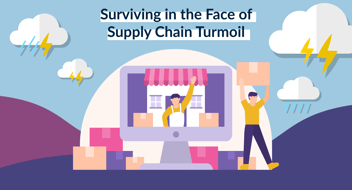CEO Corner: Resilience for the Roller Coaster
.png?width=1280&height=720&name=CEO%20CORNER%20-%20Rollercoaster%20(1).png)
If you’ve felt like your business strategy has spent more time on the ropes than in the ring lately, you’re not alone.
The last few years have taken the economy on a loop-de-loop: pandemic shocks, supply chain chaos, unexpected demand spikes, labor shortages, inflation, and now the latest twist with tariffs making a fresh appearance on the global stage. Through it all, one thing’s been constant: uncertainty.
Consumer demand isn’t gone. But it is increasingly erratic, driven by a cocktail of sentiment, necessity, price sensitivity, and increasingly, availability. And the question on every brand’s mind is: how do we build for this?
Not for stability (that might be wishful thinking) but for resilience. The kind of resilience that allows you to flex, pivot, and even grow while riding the waves of a global economy that refuses to stand still.
From Supply Chains to Sentiment Shifts
Let’s be clear: this isn’t a “crisis moment”, but it is a continuously challenging one. Costs are up. Confidence is down. Some consumer segments are thriving, others are hesitating. Add in unpredictable tariffs and trade policy, and even your best forecasting tools start to sweat.
This is the age of the Whiplash Economy and reacting isn’t enough anymore. You need to design for unpredictability.
Here’s what that really takes:
1. Resilience Starts with Shared Ecosystems
The lone-wolf strategy is officially outdated. Brands can no longer afford to view retailers as separate, parallel channels. And retailers? They don’t just need product; they need partnerships.
True resilience comes when brands and retailers operate as one network. That means shared inventory. Shared fulfillment capabilities. Shared data. Shared wins. It’s no longer about controlling the entire experience; it’s about orchestrating it together, so the customer wins every time, no matter where they shop.
2. Distributed Fulfillment = Demand Insurance
Consumers want fast. Retailers want turns. Brands want margins. These goals used to compete. Now, they can coexist, if your infrastructure allows it.
Distributed Order Management (DOM) is more than logistics. It’s a business strategy that uses proximity, inventory availability, and delivery windows to route orders where they’ll perform best, financially and operationally.
This isn’t just about saving a few shipping dollars. It’s about meeting demand when and where it shows up, especially when the peaks and valleys hit hard.
3. Global Disruption Requires Local Agility
One tariff change, one port delay, one region-specific surge and your entire demand forecast could implode. That’s why local agility is no longer optional.
Brands that empower retail partners to fulfill locally aren’t just speeding up delivery, they’re unlocking strategic flexibility. This kind of decentralization turns regional complexity into a competitive edge.
4. Don’t Forget the People on the Ground
Too many strategies forget the final touchpoint: the shop employee. They’re the ones guiding the purchase, answering the questions, and putting the product in the customer’s hands. Yet they’re often left out of the incentive loop.
Resilient brands invest here, too, with training, rewarding, and empowering retail employees to become real ambassadors. That small shift? It drives sell-through, improves customer experience, and deepens retailer loyalty.
5. Let Data Drive the Decisions… Together
You don’t need to outsmart the market. You need to outconnect it. In an environment where consumer behavior shifts week to week, your best bet is to connect data from across your ecosystem: online sales, in-store trends, fulfillment speed, inventory position, and employee engagement.
When brands and retailers both see the same data, demand becomes clearer, risks become smaller, and growth becomes shared.
The Quivers Perspective
At Quivers, we’ve seen this story unfold from every angle. Brands looking to scale DTC while protecting retail partners. Retailers trying to stay nimble while juggling supply issues and evolving consumer expectations. Shop employees who want to do more, but need the right tools and incentives to do so.
Our role? We’re the connective tissue. From DOM to ambassador management to real-time analytics, we help businesses turn fragmented operations into unified, adaptive commerce networks.
Because let’s face it: this ride isn’t slowing down. But with the right strategy, the right technology, and the right partners, you don’t just hang on, you lead the ride.
Here’s to staying ready for the next turn, the next surge, and the next opportunity… together.
Find out more: www.quivers.com/get-started



